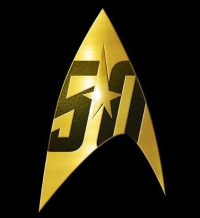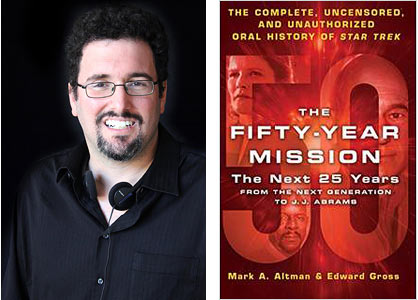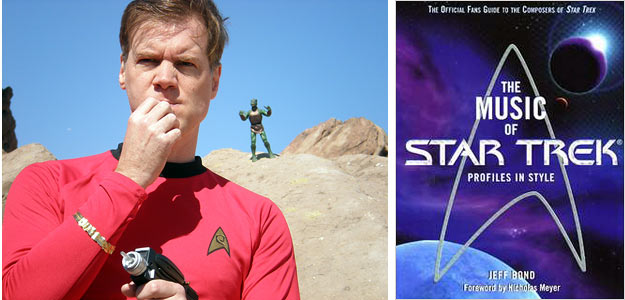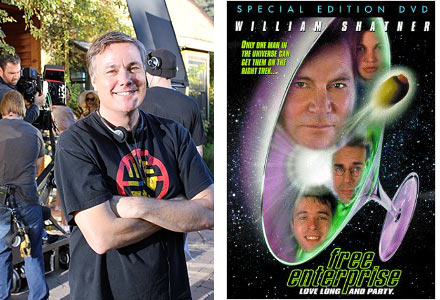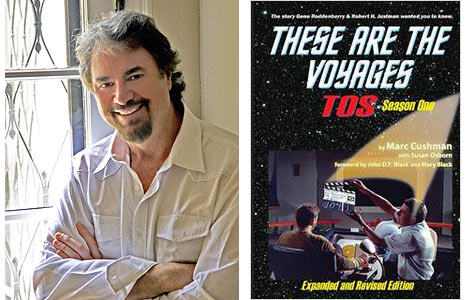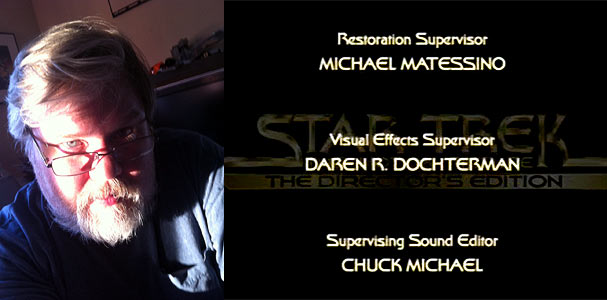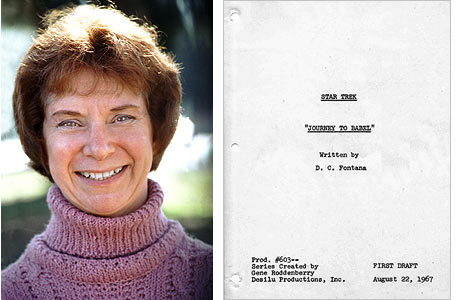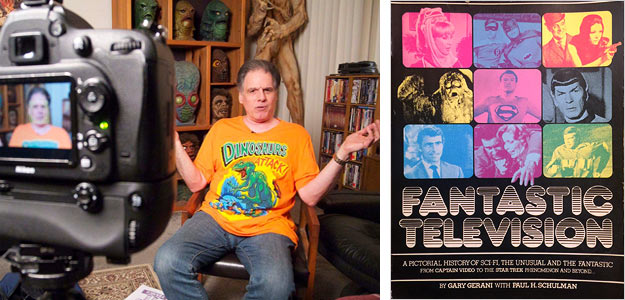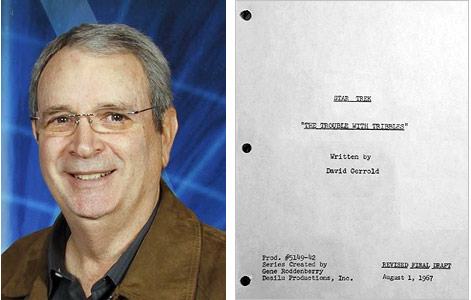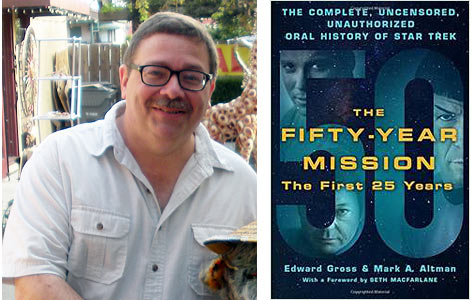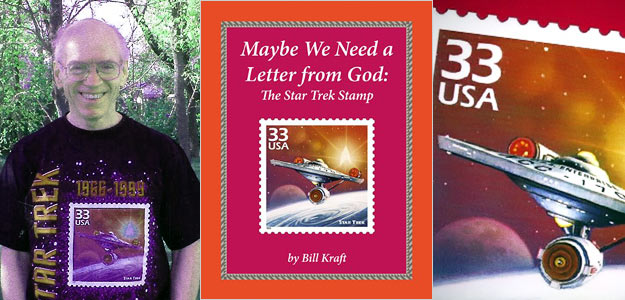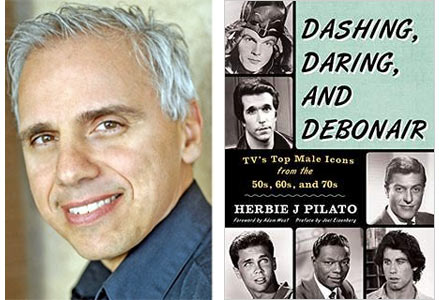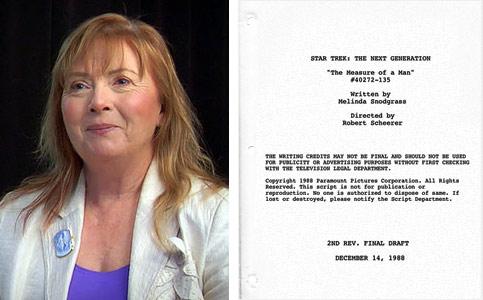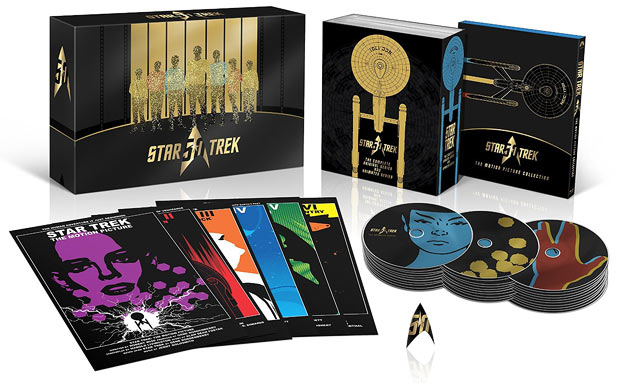Okay, it’s a big article, so let’s get right to it and introduce the participants. In alphabetical order…
Mark A. Altman has been called “the world’s foremost Trekspert.” He is co-author (with Edward Gross) of the bestselling The Fifty-Year Mission: The Complete, Uncensored, Unauthorized Oral History of Star Trek, recently published by St. Martin’s Press (currently available in hardcover, Kindle and audiobook). In addition to being the writer/producer of the award-winning romantic comedy Free Enterprise, starring William Shatner and Eric McCormack (see our roundtable on the film here), he is currently co-executive producer of The Librarians for TNT and has been a writer/producer on such series as Agent X, Necessary Roughness, Castle and Femme Fatales, which he co-created for Cinemax.
Jeff Bond is the author of The Music of Star Trek (Lone Eagle, 1999). He also wrote Danse Macabre: 25 Years of Danny Elfman and Tim Burton (included in The Danny Elfman & Tim Burton 25th Anniversary Music Box, Warner Bros., 2011) and is co-author with Joe Fordham of Planet of the Apes: The Evolution of the Legendary Franchise (Titan, 2014). Jeff is the former editor of Geek magazine, covered film music for The Hollywood Reporter for ten years, and has contributed liner notes to numerous CD soundtrack releases. He also has portrayed Dr. McCoy on the Star Trek New Voyages: Phase II Internet series.
Robert Meyer Burnett directed, co-wrote and edited Free Enterprise (see our roundtable on the here) and co-produced and edited the supplemental material for the Blu-ray season sets of Star Trek: The Next Generation and Star Trek: Enterprise. He has worked as a Star Trek consultant for Viacom Licensing and edited all of the video packages at the late Star Trek Experience in the Las Vegas Hilton. He developed and produced The Hills Run Red and co-produced Agent Cody Banks and its sequel, as well as directed and edited several episodes of the Cinemax series Femme Fatales. He is the owner of Ludovico Technique, which specializes in the production of Value Added Material for DVD and Blu-ray releases. He has produced VAM for titles such as The Usual Suspects, Superman Returns, X-Men, and The Chronicles of Narnia: The Lion, The Witch and the Wardrobe. He also recently edited the award-winning Star Trek fan film Prelude to Axanar and was slated to direct the feature film Axanar before the project was hit with a copyright lawsuit from franchise rights holders Paramount and CBS and shut down.
[Editor’s Note: In the interest of full disclosure, Digital Bits editor Bill Hunt was also the screenwriter for the Axanar feature film project.]
Marc Cushman is a Los Angeles-based screenwriter and director, who also writes books documenting the making of classic TV series, including the Saturn Award winning three-book set These Are the Voyages, (Jacobs Brown Press, 2013-2015; www.thesearethevoyagesbooks.com), with one volume for each of Star Trek’s three broadcast seasons. Other books include I Spy: A History and Episode Guide to the Groundbreaking Television Series (McFarland, 2007) and Irwin Allen’sLost in Space: The Authorized Biography of a Classic Sci-Fi Series, (Jacobs Brown Press, 2016), tracing the development and production of the show that paved the way for Star Trek, as well as the early career of creator/producer Irwin Allen.
Daren R. Dochterman has worked in the motion picture industry for over thirty years as a concept designer and production illustrator, storyboard artist, visual effects artist, and art director. He’s been a director, editor, sound man, model builder, compositor, and actor. He also is an instructor at Art Center College of Design in Pasadena, California, and creative director of the Star Trek Original Series Set Tour. He was also Visual Effects Supervisor on Star Trek: The Motion Picture—The Director’s Edition and is arguably the only person in the world to do a Gene Roddenberry impression.
Dorothy Fontana was the Story Editor for the first two seasons of Star Trek and writer (or co-writer) of several episodes including Charlie X, Tomorrow Is Yesterday, This Side of Paradise, Journey to Babel, Friday’s Child, and The Enterprise Incident. Subsequent Trek series scripts included Yesteryear (The Animated Series), Encounter at Farpoint (The Next Generation), Dax (Deep Space Nine) and To Serve All My Days (Star Trek: New Voyages). As well, she has written for numerous other TV series, including Babylon 5, Bonanza, Dallas, Land of the Lost, Logan’s Run, The Six Million Dollar Man, The Streets of San Francisco, and The Waltons.
Gary Gerani is the author (with Paul H. Schulman) of Fantastic Television: A Pictorial History of Sci-Fi, The Unusual, and the Fantastic from Captain Video to the Star Trek Phenomenon and Beyond (Harmony, 1977). Gary is known as the Card King, having written and edited more trading cards than anyone else, including the Topps Star Wars sets, which Abrams Books has recently reprinted in book form. He co-wrote the screenplay for Stan Winston’s Pumpkinhead and is currently directing a documentary about the film/TV composer Billy Goldenberg (Spielberg’s Duel, among others). He also owns his own publishing company, Fantastic Press, in a partnership with IDW.
David Gerrold is the writer of several episodes of the various Star Trek shows, including The Original Series (The Trouble with Tribbles), The Animated Series (More Tribbles, More Troubles and Bem) and The Next Generation (Blood and Fire, which was rejected by TNG producers but eventually produced as an episode of Star Trek: New Voyages). His Star Trek-themed non-fiction includes The Trouble with Tribbles: The Birth, Sale, and Final Production of One Episode (Ballantine, 1973) and The World of Star Trek (Ballantine, 1973; revised in 2016), and Trek-themed fiction include The Galactic Whirlpool (Bantam, 1980) and Encounter at Farpoint (Pocket, 1987). Non-Trek-themed novelettes and books penned by Gerrold include The Martian Child (1994), and the Star Wolf (Spectra, 1972-2004) and The War Against the Chtorr series (Spectra, 1983-1993). He has also written for Babylon 5, Land of the Lost, Sliders and The Twilight Zone (1985).
Edward Gross is a veteran entertainment journalist who has been on the editorial staff of a wide variety of magazines, among them Geek, Movie Magic, Cinescape, Starlog, SFX, Life Story, CFQ and Sci Fi Now. He has authored or co-authored such nonfiction books as Planet of the Apes Revisited, Rocky: The Complete Guide, Above & Below: A 25th Anniversary Beauty and the Beast Companion and summer 2016’s two-volume The Fifty-Year Mission: The Complete, Uncensored, Unauthorized Oral History of Star Trek. Currently he serves as executive editor on Empire magazine’s empireonline.com/us.
Bill Kraft spearheaded the successful 13-year campaign (1985-1998) to honor Star Trek on a U.S. postage stamp. He grew up on the remote plains of Strasburg, North Dakota, and cultivated his passion for movies at the town’s only theater until television arrived in 1953. He got his B.A. in English from St. John’s University, Collegeville, MN, and taught high school English at Pipestone, MN, and at St. Cloud Cathedral High School, St. Cloud, MN. He has a passion for the writings of Thomas Wolfe and Washington Irving and fulfilled life-long ambitions with pilgrimages to Wolfe’s gravesite, Thomas Wolfe Memorial in Asheville, NC, and Irving’s residence of Sunnyside on the banks of the Hudson River in New York. Bill’s favorite movie is Lawrence of Arabia, but the last 15 minutes of Star Trek: The Motion Picture became the impetus behind his “conversion” to Star Trek and the motivation behind the Star Trek stamp campaign and his book Maybe We Need a Letter from God: The Star Trek Stamp (2013). Bill and his wife Karla live in Sauk Rapids, MN.
Herbie J Pilato is a classic television historian and the author of Dashing, Daring, and Debonair: TV’s Top Male Icons from the 50s, 60s, and 70s (Taylor Trade Publishing, 2016), which includes profiles of William Shatner, Leonard Nimoy, DeForest Kelley and Gene Roddenberry. The writer, producer, lecturer and consultant has penned numerous other books, including Glamour, Gidgets, and the Girl Next Door: Television’s Iconic Women from the 50s, 60s, and 70s (Taylor Trade Publishing, 2014), The Bionic Book: The Six Million Dollar Man & the Bionic Woman Reconstructed (Bear Manor Media, 2007), The Bewitched Book (Delta, 1992), Bewitched Forever: The Immortal Companion to Television’s Most Magical Supernatural Situation Comedy (Tapestry, 1996; and updated in 2004), Twitch Upon a Star: The Bewitched Life and Career of Elizabeth Montgomery (Taylor Trade Publishing, 2012), The Essential Elizabeth Montgomery: A Guide to her Magical Performances (Taylor Trade Publishing, 2013), and NBC & Me: My Life as a Page in a Book (Bear Manor Media, 2008). He heads the production company Television, Ink., was a consulting producer on the DVD season sets of Bewitched, CHiPs, Kung Fu and The Six Million Dollar Man, and established The Classic TV Preservation Society.
Melinda Snodgrass was the Story Editor for the second season of Star Trek: The Next Generation and writer (or co-writer) of several episodes including The Measure of a Man, Pen Pals and The High Ground, as well as the Trek novel The Tears of the Singers (Pocket, 1984). She is a recovered lawyer, a screenwriter and novelist with works available from Tor Books — The Edge of Reason, The Edge of Ruin and The Edge of Dawn, and Titan Books — The Imperials series (The High Ground and the soon to be released Evil Times). She’s working on the third book in that series. She also co-edits and writes for the Wild Cards book series with George R.R. Martin, and is the executive producer on the upcoming Wild Cards TV series. As well, she has written for numerous other TV series, including L.A. Law, The Outer Limits (1995-2002), Profiler, and Sliders. She is an FEI dressage rider who owns two Lusitano horses — her stallion Vento da Broga, and her new young horse Donhador.
The interviews were conducted separately and have been edited into a “roundtable” conversation format.
Michael Coate (The Digital Bits): In what way is Star Trek worthy of celebration on its 50th anniversary?
Mark A. Altman: Star Trek is a remarkable cultural touchstone. It’s more than just a TV series, but one of the most significant landmarks of 60s popular culture. Along with the Beatles, James Bond and Woodstock, it is the 60s. Star Trek wasn’t just a science fiction series, it had something meaningful to say about the human condition; who we were and are as a race. It also was remarkably prescient in terms of anticipating technological developments, if not over the next 300 years, certainly the next 30 years. It is hard now to realize the immense achievement of the series given the constraints of the time in advancing the nature of visual effects, futurism and humanism and is being justifiably lauded for its remarkable achievement.
Jeff Bond: It’s stunning and gratifying to me that Star Trek is still viable and a huge part of our culture 50 years after it was first broadcast and almost 50 years after it essentially failed and was cancelled. It’s certainly one of the most amazing success stories in entertainment.
Robert Meyer Burnett: Aside from an errant voyage by James Cameron to the bottom of the Marianas Trench, humanity no longer has any more real frontiers to conquer. Sure, technology marches on, and assuming we survive the 21st Century, biotech, AI and god knows what other Lawnmower Man comes screaming down the pike, will keep changing human life, hopefully for the better, but we currently don’t have many places to go, nor the technology to get there…. But Star Trek constantly reminds us one day, we will indeed boldly go where no one has gone before, and ultimately, it will be a good thing, a very good thing, we’ve done so. From the first men cowering in caves from the moonlight, who awakened the next morning to push forward over the next hill, an element of humanity must constantly be moving, exploring and pushing the boundaries of our experience of the world, indeed the universe, around us. To be the first person to stand on a mountaintop, feel the wind through your hair and see the unique sunrise from that vantage point, informs our very soul…. Star Trek reminds us we must continue to strive for the stars, continue to push the boundaries of knowledge and imagination, even in the face of the constant turmoil of our day to day existence here on this planet. Perhaps now more than ever, mankind needs to be reminded although we are a mere speck of cosmic dust, we have the ability to reach for the very secrets of the universe itself.
Marc Cushman: If ever a series was worthy of having a big bash of a 50th anniversary celebration, this is the one…. Following I Spy, from one season earlier, Star Trek helped to establish multi-racial casting on television in non-stereotypical roles. In fact, this was the first multi-racial series on primetime TV in the U.S. And the first to send a black woman into outer space! It brought us TV’s first interracial kiss — between white and black, white and green, human and Vulcan, you name it! And that is major…. Gene Roddenberry was into taking chances because he was a writer with much to say. Back in the mid-1960s, entertainment shows in primetime were not supposed to touch on hot topic issues, and few dared to risk upsetting the networks. But Roddenberry and Star Trek did, every week. We saw stories about racism, sexism, religion, overpopulation, Vietnam, the U.S.S. Pueblo, and on and on. And America got its first look at the mini-skirt! With these type of stories, and its sexiness, Star Trek was considered by many TV critics to be America’s first “adult science fiction series.”…. Star Trek was the first to win a Hugo award as “Best Science Fiction Presentation of the Year” (in 1967 for The Menagerie, a year when three of the five nominated “films” were Star Trek episodes), and again, in 1968 (The City on the Edge of Forever, a year when all five nominations were for episodes from Star Trek!). It was the first sci-fi series to be nominated for a primetime Emmy award as “Best Dramatic Series” (two years in a row, in 1967 and 1968). And Leonard Nimoy was the first actor in a science fiction series to be nominated for a primetime Emmy (as Best Supporting Actor in a Dramatic Role), three years in a row, no less, in 1967, ’68 and ’69! These accomplishments are historic, and opened people’s minds and the doors of the entertainment industry for acknowledging science fiction in the future…. It was the first series to film a miniature (if you can call that eleven foot, two inch Enterprise they used a miniature) in front of a blue screen. And the first to use several animation plates to create moving stars, as a composite shot to combine with that of the Enterprise. This was state of the art for its time. It invented the art! And let’s not forget the innovations in science that came about as a result of Star Trek — a mere TV series. Many inventors from the last thirty years have admitted that they got their ideas from watching Star Trek when they were children. Did your first cell phone look like Kirk’s flip-open communicator? Of course, and for good reason. Censor activated automatic doors, Bluetooth, CDs, DVDs the PC, the Internet, the MRI, Kindle, and on and on — you can see all of these things decades before they were invented in Star Trek episodes. And you can be sure the inventors saw them too.
Daren R. Dochterman: Star Trek existed in a strange nexus of time and history. It happened as societal pressures were boiling over, and technical advancements were heading to one of the most important events in human history, the moon landing. It was a barometer of these happenings, it was a release valve, it was a sign post leading to a world where all these factors had advanced and represented a future where mankind would not only survive, but flourish. Its integrated cast didn’t call attention to itself, by saying, “Hey, look at how progressive we are being”… it just was. It inspired to show where we might be going, while masquerading as a simple adventure show. It is almost unheard of for something from popular culture maintaining its presence 50 years later… and I think that it is interesting how many things from that specific time period are still remembered fondly with vociferous fan bases, but none of those other pop culture offerings have gone through so many reworkings and variations and still held on to its innate qualities. With all the permutations and up-rezzing that has gone on to the “franchise,” the original 79 still remain an interesting and engaging look into both our past, and our future.
Dorothy Fontana: How many other fifty-year-old shows are still being syndicated — and adored by fans — the same way Star Trek is? It’s still a kick for me to meet younger people who tell me they watched the show with their parents and are still watching it in syndicated reruns. And they’re buying the reissued shows on DVD and Blu-ray, to watch them all over again in these new formats. The stories and the characters still hold up — and still engage and entertain audiences.
Gary Gerani: It was the first science fiction series with fully-defined characters that you cared about, and the fantastical notions never insulted your intelligence — they were based on real scientific principles or theories. It also helped viewers to appreciate racial diversity, using science fiction to show us the way to a smarter, more progressive and hopeful future.
David Gerrold: No other television show has had the cultural impact of Star Trek. It has become an iconic American mythology. Star Trek predicted tablets and talking computers and personal communicators, sliding doors and silvery discs for storing data — and now we have all those things. And more. But more than that, Star Trek continues to inspire the audience with an optimistic vision of the future, a future in which everybody is valued for what they can contribute.
Edward Gross: In the same way that James Bond was back in 2012 or the 50th anniversary of The Beatles’ “invasion” of America was in 2014: to have an element of pop culture not only be celebrated, but to still be thriving half a century after its inception is remarkable. Especially today when things have become so disposable. New feature film, new television series, and a franchise that remains so revered is absolutely worthy of celebration.
Bill Kraft: Star Trek broke ground for science fiction on television. Before then, TV science fiction was strictly Saturday morning “kid-stuff,” which no one took seriously. It didn’t deal with ideas or comment on the human condition as Star Trek does. Star Trek’s longevity and sheer output of over 700 hours of storytelling attest to its durability. I think the first 50 years are but a harbinger of another 50 years or more. It’s time to acknowledge and celebrate the achievement of one of the most durable franchises in the annals of entertainment and pop culture.
Herbie J Pilato: First and foremost, the scripts, visuals, and characters were vibrant with imagination, wonder, hope, discovery, excitement, and adventure… all the colors of the Universe, however they are defined within the specific confines of optimum storytelling. The casting of each character, be they a regular or a guest character, was on-the-money. The importance of casting far too-many times is ignored when producing any kind of production for television, film or stage, for that matter. And on Star Trek — the original series, the casting was pristine.
Melinda Snodgrass: Star Trek presented the possibility of a united Earth and people who no longer saw national borders or skin color. That was a major achievement during the 1960s while fear of Communism raged and African-Americans were struggling for equal protection and acceptance in their own country.

Coate: Can you recall when you first saw the show?
Altman: I’m not sure if my first exposure to Star Trek was watching The Animated Series on NBC or watching repeats on WPIX Channel 11 in New York. What I do remember is watching it a lot. And then immersing myself in the James Blish novelizations as well as the Gold Key comic collections surrounded by a lot of Mego toys and my prized set of Franz Joseph Blueprints and the indispensable Technical Manual. Virtually every night and Saturdays, and like many of my generation, tape recording our favorite episodes since VCRs did not yet exist. The other great way to relive a favorite episode was reading the Fotonovels, a long extinct way of telling a story, which was like a comic book made up of frame grabs and word ballots. Those are some of my most cherished Trek collectibles. As a kid, I recall getting Leonard Nimoy’s autograph at Macy’s and I asked him about In Search Of instead of Star Trek since he had just published the infamous I Am Not Spock book. I guess you could say that was the beginning of my career as a journalist.
Bond: I actually remember this vividly — our family was on vacation the week of the moon landing in July, 1969 — I remember watching the moon landing on a television in our room at a little vacation resort an uncle of ours ran. They also had a kind of lodge/bar with a color television mounted up over the bar — for a kid back then it was rare and exciting to see a color TV. I remember being in the bar at night with my dad and seeing Star Trek playing on the TV — I remember seeing the engineering room and I’m pretty sure I remember seeing the Klingon ship so I’ve always thought the episode must have been Elaan of Troyius — it would be interesting to see when the rerun of that episode ran that summer. I was 8 and I had seen 2001: A Space Odyssey and been kind of freaked out by that, and I remember getting a little of the same feeling from Star Trek — thinking it all seemed very strange, bizarre and a little scary. But then within a year or two I was eagerly watching episodes of it in daily syndication.
Burnett: I don’t remember a time when I ever didn’t see it. Although my mother maintains I’ve watched Trek since I was three.
Cushman: It was The Devil in the Dark, when NBC repeated the episode during the summer of 1967. We couldn’t pick up the NBC affiliate out of Portland, Oregon, where I grew up on a farm, except in the summer months when it would fade in and out. All the other kids at school, and the teachers too, had been talking about Star Trek for six months. I was the only kid in my class who couldn’t watch it. And then, finally, Channel 8 out of Portland faded in on the night The Devil in the Dark had its repeat broadcast. The show seemed huge to me and my family; we’d never seen anything like it. And it seemed to be about something — it had feeling, and a message. It challenged us as most TV shows did not back in those days. My parents and sisters and I were immediately hooked! The first episode I saw in color was This Side of Paradise, also during that summer, while visiting a friend and watching it at his house with his family on their brand new RCA color TV. I had never imagined anything so vibrant looking.
Dochterman: My earliest recollections are seeing it on TV while my Grandfather watched it. I had no idea what it was, I was probably around four or five. When The Animated Series hit in ’73, and I was enthralled by it, I began to realize that it existed in a live action show, and that was what he had been watching years earlier. When the live action show was on every weekday in syndication, I couldn’t get enough, and I was recording episodes on my dad’s old reel-to-reel tape recorder. I do recall that I watched it in black-and-white for years and years, until we finally got a color TV around 1977. What a revelation to finally see it in full glorious color.
Fontana: If you are talking about the very first pilot (starring Jeffrey Hunter), I was on the production from the first day Gene Roddenberry began the script. It was shot at Desilu Culver City, and our offices were at Desilu Gower, so I didn’t get a chance to go down to see the shooting. I did see the pilot when it was finished and ready for NBC to see. I liked it overall — though, as we know, NBC ultimately claimed it was “too cerebral” and ordered a new take on it. I was closer to Where No Man Has Gone Before, as we had offices at Desilu Culver that time. (Gene Roddenberry was producing his pilot Police Story and a Western pilot for his friend, Sam Rolfe, in that same summer, so it was easier to have our production offices at the Culver lot.) I was able to go down to the set and to see some dailies and first cut to take notes for Roddenberry. I felt the new pilot moved faster and had more science fiction elements on the screen, but the characters came through well. William Shatner put more energy into our captain, and Mr. Spock had undergone some interesting changes (no more smiles!). It was a good pilot — and that one convinced NBC we had a viable show. (Police Story and the Western did not sell.)
Gerani: I was there when the Salt Vampire started killing crewmen right and left.
Gerrold: 8:30 pm, September 8th, 1966.
Gross: It was during the second season in 1967. I was a little kid of seven in Brooklyn, New York, and my friends and I used to “play” Star Trek. I was Bones, and I specifically remember having a tiger water gun as my phaser and a binocular case as my tricorder.
Kraft: When Star Trek debuted in 1966, science fiction was a bit alien to me. I paid but causal attention to its potential as a vehicle for ideas and its allegorical and metaphorical implications. It was after I saw Star Trek: The Motion Picture in 1979 that I went back to fill in the gaps. The 1:00 am repeats on channel 5 in Bismarck, North Dakota, brought heavy eyelids with rich rewards. I really didn’t begin to grasp it all until the early 1980s.
Pilato: I am of the fortunate original watchers of the series when it initially aired on NBC, if when in its third and final season, when it was broadcast on Friday nights at 10:00 pm. But I remember it well… one episode from that season in particular. It was titled The Savage Curtain, in which Kirk and Spock meet up with Abraham Lincoln; or at least the alien illusion of what was presented as Lincoln. It was a fascinating episode to me, as Spock might say… because, for one, Lee Bergere was so perfect as Lincoln. This episode also did so well what Star Trek also did well with overall: the show always presented a tapestry of different worlds, even dimensions, connecting, through different perspectives, and yet somehow allowed the viewer to relate on a very real, and mainstream and unifying level.
Snodgrass: First night the first episode aired. It was the one about the salt monster. When that ship sailed across our color TV (the first one on our block) I was lost. This is the world I had been dreaming about my entire life.
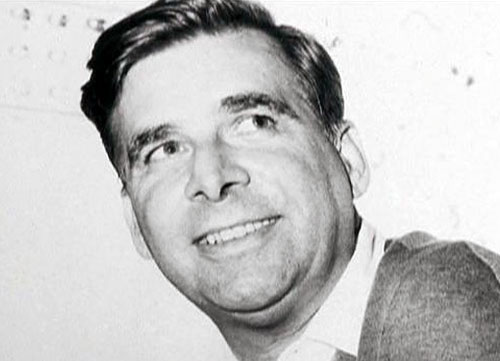
Coate: Where do you think Star Trek ranks among the all-time great TV shows?
Altman: The original Star Trek series is the best of the Star Trek shows which doesn’t negate the colossal achievement of The Next Generation or Deep Space Nine, which are both remarkable television shows in their own right, but The Original Series is the DNA on which everything else was built and was so far and beyond any other series being produced in the era that you can’t not recognize the magnitude of its achievement. In the annals of television, it ranks right alongside such shows as The Twilight Zone, The Wire, Breaking Bad, The West Wing and Hill Street Blues as one of the best television shows ever made.
Bond: I think the original series ranks among the best TV series of all time and I think the original series is the only one that was really on the cutting edge of quality television at the time. The other shows all had their strengths and I particularly enjoyed Deep Space Nine and The Next Generation, and both of those had some very strong seasons and episodes, but I think if you rank them against the best TV shows on the air when they were running, they were not quite up to the level of the best shows, but you could definitely put the best of the original series up against any dramatic TV show of the late 1960s. I think that gets lost in the fact that the original show was very much of its time and does some things you couldn’t get away with today from a cultural standpoint. It was both ahead of its time and at the same time somewhat hobbled by where society was in terms of sexism, etc., so now it’s common for people to look back on the original show as very primitive and kind of goofy because of the style, but you have to rank it against what was being done at the time.
Burnett: Television has finally surpassed the cinema in terms of a storytelling experience... but the original Star Trek changed the television medium forever... and I’d consider it just below The Twilight Zone as the most important television show of the 1960s. Where it ranks in terms of all television shows? With The Sopranos, The Wire, Game of Thrones, Mad Men, Walking Dead and Breaking Bad... who knows what history will say?
Cushman: I truly believe the original Star Trek is among the Top 10 best series ever made for television. We cannot, and should not, expect it to match the scope and production values of shows made today, with their greater budgets and the availability of CGI. Looked at in its time, Star Trek was state of the art and cutting edge in all ways. The thing that makes it timeless, and allows it to outrank so many series that have come along since, is the writing. The themes of those classic 79 episodes gave that series importance. Many series today merely attempt to entertain. Star Trek entertained us as well as enlightened us…. As far as the other Star Trek series are concerned, the first remains the best. From a writing perspective, those characters on the first series were far more interesting because they were flawed. All the best characters are. Spock’s inner-conflict alone outdoes all the others to come along since. And those flaws make the original series the best of all the Treks.
Dochterman: There is no question (or comparison for that matter) that Star Trek is one of the most widely known and honored shows in a crowd of widely known and honored shows. In terms of worldwide familiarity, instant recognition, and number of people who know who Kirk and Spock are, it’s at the top. I enjoy all of the spin off shows and movies to some extent. Certainly not equally, though. But for Trek in its purist form, un-diluted, not distracted by the need to have unrestricted mass appeal, there is only The Original Series. It is honest. It doesn’t try to be anything else but what it is: an entertainment rooted in cowboy shows, thrust into a hopeful future where people are still people, and the characters are worthy of emulating. These are people we could aspire to be like. They were the best at what they did, and no one thought that they needed to be made “more accessible” to people. They raised expectations. People were successful in Star Fleet because they earned it, not because they were lucky. (We saw at least a couple examples of poor unready characters who weren’t good enough to make the grade — Ben Finney in Court Martial or Robert Merrick in Bread and Circuses — they were not capable of achieving greatness, and they were pitied because of it.) This created more drama and gave viewers the feeling that you could do anything if you followed the lead of the main characters.
Fontana: In my opinion, Star Trek is in the top ten of all-time great TV shows. While it is a different kind of show (anthology/half hour/contemporary and futuristic in its episodes), Twilight Zone would probably be ranked up there too and possibly top the list for science fiction on TV. But for character strength and audience attraction, storytelling in a powerful continuing universe, and audience recognition — it has to be Star Trek.
Gerani: My four biggies are The Outer Limits, The Twilight Zone, Star Trek, and The Prisoner. Although Star Trek: The Next Generation was more sophisticated than its predecessor, those original characters remain fresher and stronger. It was almost like Mister Roberts in space, but with action-adventure thrown in.
Gerrold: I think The Original Series has to be considered as important as I Love Lucy, M*A*S*H, All in the Family, and The West Wing — because watching those shows, you ended up feeling good about people. At our silliest, at our most courageous, even at our worst, we all have possibilities. Great entertainment transforms the audience — that’s what makes it great.
Gross: Maybe I’m biased because of my life-long love of Trek, but it’s pretty high up there, mostly because when the scripts work, they still manage to transcend time and illuminate who we are as a people. And the actors, led by Shatner, Nimoy and Kelley, absolutely sold the situations they found themselves in. I’d have to rank The Original Series at the top of the various series, with Deep Space Nine a close second.
Kraft: I would rank Star Trek among the top five best TV shows and The Original Series first among the Star Trek canon. Your first love is the one that makes the greatest impact because it introduces you to something new. The original series was my first love. Even though you feel great affection for the loves that follow, it can never be quite the same. It’s like a parent being asked which is his/her favorite child. You love them all, but maybe not in the same way. Star Trek: The Next Generation might be more complex in some ways and ranks a close second. Because of the Kirk, Spock and Bones dynamic, however, and the wonderful interplay among those three, I’d give the original series the edge.
Pilato: To me, Star Trek is definitely in the top of all-time favorite shows, joining series like The Twilight Zone, Bewitched, Kung Fu, Father Knows Best, Perry Mason, All in the Family, The Andy Griffith Show, Dr. Kildare, Route 66, and The Defenders. I enjoy all the sequels, especially Star Trek: The Next Generation… and the first season of The Next Generation, in particular… because in many ways that first season was very similar to The Original Series in execution. I also enjoy Star Trek: Deep Space Nine. That said, like all true Trekkers… who are concerned with the show’s philosophies, and Trekkies… who are into the costumes and make-up, etc… are looking forward to the new Star Trek: Discovery series, which hopefully will create new Trek-isms like the “Triad of Stability,” represented by William Shatner’s Captain Kirk; “Logic,” represented by Leonard Nimoy’s Mr. Spock; and “Emotion,” represented by DeForest Kelley’s Dr. McCoy. The Discovery show will be a hit because of the key creative force behind the scenes, including Gene Roddenberry’s son, Rod Roddenberry, and Nicholas Meyer, who directed Star Trek II: The Wrath of Khan, and Star Trek VI: The Undiscovered Country, the best of the feature films. The Animated Series was a wonderful sequel to the original show, as it featured a reunion of the original cast, if only via voiceover. The Animated Series lasted only two seasons on NBC, the original network for the first series, which lasted three years. So, with those two shows combined, the initial “five year mission” of the original Enterprise crew was ultimately completed.
Snodgrass: I prefer the original show to all the rest of the shows and the movies. There were some dreadful episodes, but there were also brilliant thought provoking episodes.

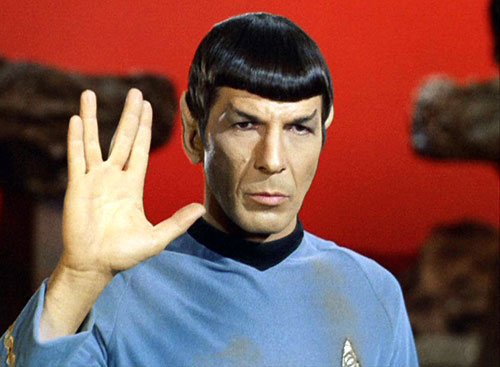
Coate: Which are the show’s standout episodes?
Altman: City on the Edge of Forever. Other favorites are Mirror, Mirror; A Taste of Armageddon and Arena. And from The Next Generation: Q Who, Who Watches The Watchers, The Survivors, All Good Things and Trials and Tribble-ations, and In the Pale Moonlight on Deep Space Nine. Also, Mudd’s Passion and Yesteryear for The Animated Series. Do you want to know the worst? We probably don’t have time for that. Guiltiest pleasures: Spectre of the Gun and The Savage Curtain, and The Royale from The Next Generation.
Bond: City on the Edge of Forever; Mirror, Mirror; Errand of Mercy; The Devil in the Dark — there are many original series episodes, especially in the first season and a half.
Burnett: This is a question already answered a hundred thousand times before... but I’d like to offer what I’d call a “Meat and Potatoes” episode for each series. That is... not the greatest episode, but a consistent example of what makes Trek great. For The Original Series, I offer season one’s A Taste of Armageddon, about two warring planets fighting a virtual war with computers, but expecting their actual population to pay the price in order to stave off the destruction of an actual shooting war…. For The Animated Series, I have to choose the Larry Niven-scripted Slaver Weapon. First, he incorporated elements of his own Known Space series, including the Cat-Like Kzinti, awesome antagonists I’d dearly love to see one day incorporated into “real” Trek. Any fans of the table-top role playing game Starfleet Battles love the race. Also, it’s one of the only episodes where James T. Kirk does not appear! Bryan Fuller should totally bring back the Kzinti into Discovery…. I’ve always been a fan of The Next Generation’s quiet, mysterious third season episode The Survivors, offering up an elderly couple as the sole survivors of a terrible alien attack which destroyed their entire planet. John Anderson’s superlative performance coupled with a shocking revelation makes this one of the very best of TNG’s seven season run…. DS9’s two-parter, In Purgatory’s Shadow and By Inferno’s Light remain, after The Menagerie, my absolute favorite Trek two-parter (with Chain of Command bringing up the rear). The less said about these episodes the better, but in the context of the show dramatically illustrated just how far the writing staff had come in shaking up the established status quo by offering some shocking and significant character alteration, causing signification doubt in viewer’s minds where things were going. These shows trumpeted Executive Producer Steven Ira Behr’s real desire to expand Trek storytelling beyond the bounds of traditional five-act structure and embrace the nature of true serialization which later became a staple of the current golden age of television storytelling…. Voyager’s Blink of an Eye, co-written by Star Trek: Discovery’s Joe Menosky, is my absolute favorite Voyager episode. Combining Brannon Braga’s penchant for time anomalies with Menosky’s sometimes problematic use of fringe intellectual concepts, Eye spins a heady tale of a planet out of the normal time stream, with a stuck-in-orbit Voyager itself becoming part of the collective mythology of people living there. A great stand-alone science fiction story with a surprisingly moving climax, Eye provides a fleeting glimpse of what kind of series Voyager might have been if the show concentrated more on modern science fiction concepts and less on the idea of making the long journey home…. My favorite Enterprise remains Judith and Garfield Reeves-Stevens The Forge. No one understands Star Trek from a modern perspective then the best couple in Star Trek. The authors of my very favorite Star Trek novel, Prime Directive, showed us a glimpse of Vulcan we could only scarcely ever dream of. Fantastic canon episode.
Cushman: Amok Time, when Spock loses his sanity due to an urge to mate. And Kirk must risk his career, and his command, to save the life of his First Officer, who he owes his life to many times over. This episode was so edgy when it first aired in September 1967…. Journey to Babel, an examination of a complex father/son relationship — and the true meaning of love. And the biggest gathering of aliens until the cantina scene in the first Star Wars ten years later, which owes much to this episode…. The City on the Edge of Forever — among the greatest and most heartbreaking love stories ever told on the screen — big or small — and right up there with Gone with the Wind and Somewhere in Time and the 1940s film version of The Ghost and Mrs. Muir…. The Naked Time. With only its fourth broadcast episode on NBC, Star Trek dared to strip its characters naked in front of America. Kirk confessed he obsessively loved his ship; Spock cried and admitted he was never able to tell mother he loved her; and a sweaty bare-chested Sulu, with a saber, chased crewman up and down halls with intoxicated and sadistic delight…. Charlie X — because I first saw it when I was a young teen, and my stomach was aching because I was experiencing my first crush. I didn’t know why I felt sick every time I was near her. And then Charlie admitted to the same affliction. And Kirk explained it. Nowhere else on TV had I ever seen that conversation take place before… or since. My father and I never had it. But Kirk and Charlie did, and I was there to learn from it…. The Doomsday Machine — because it’s Moby Dick in space. When we saw William Windom play Commodore Decker, who wanted to join his crew in death, we truly ached. We felt empathy. And any moving picture that can make you do that is a resounding success…. Shore Leave because everything about it is perfect! Watch it and see for yourself.
Dochterman: There are so many that it is tough to form a list that isn’t 79 episodes long. I think the ones that are the best examples of what the pinnacle of Trek can be are: Balance of Terror — it gives us a glimpse at a villain that is completely understandable and honorable. The Enemy Within — a fascinating look at the nature of man’s good/evil aspects. The Doomsday Machine — old-fashioned, nail-biting adventure filled with thrills and danger. Amok Time — a fun look at the mysterious culture of Vulcan. The Enterprise Incident — a nice cold war adventure. And Requiem for Methuselah — one of my all-time favorites from the often belittled third season.
Fontana: In no particular order — The City on the Edge of Forever, The Trouble with Tribbles, The Devil in the Dark, This Side of Paradise, Journey to Babel.
Gerani: Hmmm.… The Cage/The Menagerie; Where No Man Has Gone Before; The Corbomite Maneuver; Balance of Terror; Mirror, Mirror; The Doomsday Machine.
Gerrold: Mirror, Mirror; City On The Edge of Forever; Balance of Terror; Devil In The Dark; A Taste of Armageddon; The Corbomite Maneuver; Doomsday Machine; Journey to Babel; Paradise Syndrome; Day of the Dove; Shore Leave....
Gross: The Devil in the Dark — gives a whole new meaning to the adage of not judging a book by its cover. Metamorphosis — a treatise on the true nature of love, and one of Shatner’s finest moments as Kirk. The Trouble with Tribbles — they proved Star Trek could be funny without losing an ounce of its integrity. A Taste of Armageddon — not usually a Top 10 episode, but a wonderful allegory of Vietnam. Space Seed — Ricardo Montalban as Khan goes up against William Shatner as Kirk! Balance of Terror — A World War II submarine film transported to space with genuine tension and characterization. It just goes on from there.
Kraft: (1) The City on the Edge of Forever. Harlan Ellison’s tale employs a familiar plot device, time travel, and infuses it with a very poignant human theme of love, sacrifice and ethical dilemma. Kirk must choose between his love for Edith Keeler and humankind’s common good. Edith Keeler’s death for a greater good foreshadows Spock’s death in The Wrath of Khan when Spock decides that “the needs of the many outweigh the needs of the few.” (2) The Doomsday Machine. It’s not only a tale of pulsating suspense, but also a cautionary tale about the perils of technology run amuck in the form of a super weapon that turns into a Frankenstein monster. I interpreted the narrative to be an admonition about nuclear war and the potential extinction of the human race. (3) Errand of Mercy. Both sides get their comeuppance in this tale of planetary meddling by the Federation and the Klingon Empire. It puts the Prime Directive at the forefront and reminds us of its wise guiding principle. Kirk is flummoxed when asked by the Organians if he’s defending the right to start a war. The Klingon commander, of course, remains blinded by his bloodlust. His only regret is that he was cheated of a war that “would have been glorious.” Human and Klingon hubris are brought down a peg. The Organians are truly the ethical/moral superiors. (4) Space Seed. Ricardo Montalban’s charismatic Khan and the moral/ethical implications of the Superman theory highlight this episode. Do superior intelligence and strength (Khan) absolve the inevitable abuse of power that comes with it? Are “Supermen” above the moral imperatives of compassion and mercy? Again Trek poses the big ethical and moral questions. Apparently the learned Khan had no acquaintance with the catastrophic consequences of the Superman theory in Dostoyevsky’s Crime and Punishment or was blinded to those consequences by ego and hubris. (5) A Taste of Armageddon. This episode parallels the horrors of the Vietnam War. As never before, that war invaded the living rooms of every home in America with an intimate immediacy and revulsion. It was like a ringside seat at a nightmare courtesy of the national media. When Kirk destroys the disintegration chambers in which millions are “painlessly” disposed of as “antiseptic casualties of war” waged by computer simulation, it forces the warring factions to begin negotiations toward a treaty or face the alternative of real blood and carnage.
Pilato: There are so many wonderful and favorite episodes. Miri…with Kim Darby. Metamorphosis…with Elinor Donahue. Or City on the Edge of Forever…with Joan Collins, just to name a few.
Snodgrass: Charlie X, Balance of Terror, Trouble with Tribbles, The Devil in the Dark.
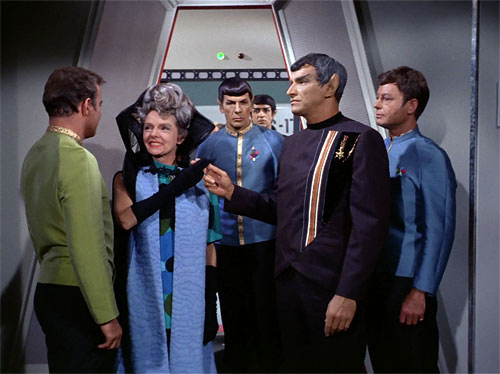
Coate: If you could name only one, which episode is your favorite?
Altman: I’m boring. City on the Edge of Forever. (The syndication cut for WPIX where the scene of the bum picking up and shooting himself with the phaser is omitted.)
Bond: Amok Time still has my favorite moment in all of Star Trek, which is the moment when Spock realizes that he hasn’t killed Kirk, that Kirk is alive, and the outburst of pure joy from that character. I think it’s one of the greatest moments on television, period, because in just about one second it peels the mask off this character and shows this incredible evolution from a remote, mysterious alien to a character that we know feels very deeply. It’s a great science fiction story written by a great science fiction writer (something the new Star Trek shows really lacked for the most part) and a magnificent character study that gets at what Star Trek is all about, which is understanding each other.
Burnett: City on the Edge of Forever or The Inner Light? Far Beyond the Stars or Blink of an Eye? Aside from the first and last episodes, the entirety of Enterprise’s fourth season? There are over seven hundred hours of televised Trek to choose from and my answer to this question might depend any day on the price of gas at my local Chevron. But there is one episode I’ve dearly loved since I was a wee lad which nobody ever mentions in any list of their favorite episodes: the second season TOS episode The Immunity Syndrome. The one with the 11,000 mile-long space amoeba, easily once of the most compelling alien creatures to ever appear in science fiction. Beginning with Spock sensing the death of the all-Vulcan starship Intrepid, a moment directly referenced in Star Wars, the plot becomes at once scary as hell and mysteriously wondrous at the same time. From the exhausted crew of the Enterprise entering the zone of darkness to their horrifically incredulous discovery of the amoeba itself, the episode remains both a compelling mystery and very hard science fiction with tremendous character beats…. Robert Sabaroff’s crackling script contains some of the best dialogue exchanges of the entire series, including some of the very best Spock and McCoy scenes ever written. “You find it easier to understand the death of one than the death of a million. You speak about the objective hardness of the Vulcan heart, yet how little room there seems to be in yours.” — Spock to McCoy, on the deaths of the Intrepid crew…. “Suffer the death of thy neighbor, eh, Spock? You wouldn’t wish that on us, would you?” “It might have rendered your history a bit less bloody.” — McCoy and Spock on feeling empathy for the dead Intrepid crew…. “Vulcan dignity? How can I grant you what I don’t understand?” “Then employ one of your own superstitions. Wish me luck.” — McCoy and Spock, outside the hangar deck door…. And finally...one of my very favorites: “Shut up, Spock! We’re rescuing you!” “Why, thank you ... Captain McCoy.” — McCoy and Spock, as the Enterprise locks tractor beams onto the shuttlecraft…. Perhaps my love of this episode offers some insight into why Star Trek: The Motion Picture will always be my favorite Trek feature film.
Cushman: This Side of Paradise — a study in loneliness. Spock tells Kirk at the end, “For the first time in my life … I was happy.” But he gave it up, out of loyalty for Kirk. And we see how tortured and lonely Kirk is, when his crew abandons him and he is left alone on the Enterprise. Brilliant. And heartbreaking.
Dochterman: When forced, I would have to say Mirror, Mirror, for the simple reason that it is so enjoyable to see our crew trying to exist in the mirror universe, and extremely enjoyable to see the mirror counterparts caged in our universe. I just enjoy it so much every time I see it.
Fontana: I can’t name just one.
Gerani: Probably Harlan Ellison’s The City on the Edge of Forever. That one just seemed to have it all… a great premise, a strong leading lady, powerful Ellison time warp concepts, and a memorable closing line. Oh, and the glowing gateway “guardian” was a pretty cool on-set prop.
Gerrold: Obviously, The Trouble with Tribbles. It jump-started my career. Without it, I would have had a much harder time.
Gross: It’s a cliché, but The City on the Edge of Forever. The concept is brilliant, as is the execution. It is so incredibly hard to sell a love story in a self-contained 60-minute episode, but City absolutely does it. And when Kirk sacrifices that love to save history? Still so moving.
Kraft: Of all the gems in the Star Trek treasure chest, The City on the Edge of Forever sparkles the most for me.
Pilato: My favorite episode is Amok Time, in which Spock begins behaving very strangely and, come to find out, he must return to his home-planet Vulcan to marry his betrothed from birth. Due to the Vulcan ceremonial rituals explained in the episode, he ends up battling Kirk for the love of his life, seemingly killing Kirk in the process, and realizing that as he says, “having is not so pleasing as wanting. It isn’t logical, but often true.” And that remains one of my favorite lines from one of my favorite episodes.
Snodgrass: City on the Edge of Forever.
Coate: Is there an ideal “gateway” episode to introduce someone to the series?
Altman: If I was writing Trek101, I would suggest a neophyte start with The Corbomite Maneuver, which encapsulates the entire Trek philosophy in one episode, and probably The Devil in the Dark and Errand of Mercy. For The Next Generation, Measure of a Man, and Enterprise, Dear Doctor. For Deep Space Nine, watch Duet and In the Tears of the Prophets. And if you like those, binge the next six years.
Bond: I use my wife as an example for this — she’s never had any interest in Star Trek and I made a huge mistake when I first met her by showing her Mirror, Mirror, which has Kirk going into a parallel universe and having to behave like some savage, pirate version of himself, and dealing with an evil Spock who’s wearing a beard — the whole episode basically introduces a completely different TV series concept, which works if you’ve spent a year or so watching the characters, but to have someone come in cold who knows nothing about Star Trek, it’s just asking too much. I actually think The Corbomite Maneuver is a perfect introduction to the characters, and it was designed to do exactly that, but because back then it took them so long to finish the special effects it wound up running much later in the first season. It’s also tough for modern audiences to deal with Clint Howard playing an alien as a little kid, I think — you could get away with that and it was an original idea back then but it’s tough for modern audiences. I would go back to Amok Time — it’s just a great personal story that gives you tremendous insight into the Vulcans and Spock, and his relationship with Kirk. And just to be controversial, the first J.J. Abrams movie is actually a terrific introduction to the characters of Kirk, Spock and McCoy, and I’m sure that has brought a lot of younger viewers into the franchise.
Burnett: It really depends on the person. But I’ve maintained the very best Star Trek gateway episode is The Corbomite Maneuver. Everything you need to know is in those 52 minutes. Great science fiction, a great mystery and a great conclusion. Plus, the First Federation is a fantastic conceit. And booze.
Cushman: I always thought The Corbomite Maneuver served as a great introduction to Star Trek. It was the episode Gene Roddenberry wanted to open the series with on NBC, but the photographic effects weren’t ready. So I showed that to my son first, when he was 12. It bored him to death. Too slow paced for today’s kids. So then I showed him Journey to Babel and he loved it.
Dochterman: Well, it’s a very serious subject to me, and a very difficult question to answer thoroughly. But I think that it depends on the person. If they are likely to react better to action or Klingons, then I would say Balance of Terror or Errand of Mercy. If they are more open to science fiction or character moments, City on the Edge of Forever or Bread and Circuses. And if they respond better to fun romps, then perhaps The Trouble with Tribbles or I, Mudd. Of course, The Menagerie gives you a spoon fed version of The Cage, along with a fascinating sci-fi and character framework.
Fontana: This is a difficult question. I would choose The Devil in the Dark, though it is a later episode in the first season. The reason is, our captain and crew are presented with a situation in which “something evil” is killing miners — endangering the working people, their livelihoods and the production of the planet — and our team has to solve the problem. And then, through Spock’s mind meld ability (I believe that was the first time it was used), they discover the creature is not a murdering, mindless beast but a mother protecting its young. Pure, perfect Star Trek — and unlike anything anyone else would have done. (Thank you, Gene Coon.)
Gerani: Corbomite is a good choice, as it dramatizes the mission of the Enterprise and enables viewers to experience both the fear and wonder associated with first contact.
Gerrold: I have been told by many that The Trouble with Tribbles is a good start, but I disagree because it’s so different from many of the other episodes. I’d say start with The Man Trap, which was also the first episode broadcast. It hooked me.
Gross: I’ll be honest, the first episode that popped into my mind was The Corbomite Maneuver, which happens to be the first episode filmed after the pilots. It captures the mystery of the unknown, ultimately demonstrates that what we encounter out there isn’t necessarily dangerous, has Kirk make mistakes as a leader, there’s a bit of sniping followed by reconciliation between the captain and Spock, and Mr. Bailey — despite whiney personality — proves to be an appropriate surrogate for the audience.
Kraft: I would recommend The City on the Edge of Forever because it is science fiction that is at once so very human and so ethically complex. Sometimes science fiction seems abstractly remote, more about machines and ideas than about people. The City on the Edge of Forever proves that science fiction can be poignant and smart.
Pilato: I would say you can’t go wrong by watching Miri, Metamorphosis, City on the Edge of Forever, or Amok Time.
Snodgrass: I would probably use Tribbles.
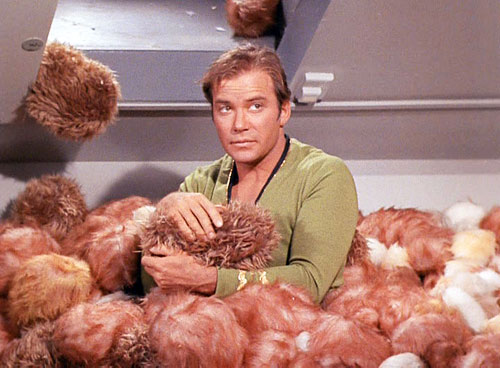
Coate: What are your thoughts on the various home-video releases and season sets of the series and, in particular, the new visual effects shots added into selected episodes?
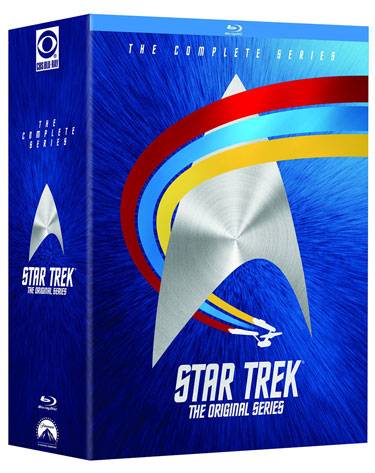 Altman: I am deeply appreciative that the Blu-rays of The Original Series feature both versions of the shows as I was deeply unhappy with the new VFX for the series which were rushed and have largely replaced the original effects on SVOD which is unfortunate. I always felt like the new effects looked like a video game. With more time and money this could have been avoided. I prefer to watch the HD versions with the original effects…. I think The Next Generation Blu-rays were really well done. Beautiful VAM [Value Added Material] from Roger Lay and Robert Meyer Burnett and the re-compositing of the original film elements was done tastefully and smartly. They look great and CBS should be lauded for the care and money they lavished on this restoration project. I also think the Enterprise sets are terrific due to all the fantastic VAM that Roger Lay created. Really insightful material that actually helped elevate my appraisal of that often maligned series. I really hope at some point CBS tackles the release of Deep Space Nine which warrants a proper restoration, but it’s complicated due to the nature of the standard-def VFX and primitive early CG. My fervent hope, however, is that the movies do get a full 4K restoration akin to the Lowry Bond restorations in the very near future. And I’d love to see a version of Trek V with new VFX.
Altman: I am deeply appreciative that the Blu-rays of The Original Series feature both versions of the shows as I was deeply unhappy with the new VFX for the series which were rushed and have largely replaced the original effects on SVOD which is unfortunate. I always felt like the new effects looked like a video game. With more time and money this could have been avoided. I prefer to watch the HD versions with the original effects…. I think The Next Generation Blu-rays were really well done. Beautiful VAM [Value Added Material] from Roger Lay and Robert Meyer Burnett and the re-compositing of the original film elements was done tastefully and smartly. They look great and CBS should be lauded for the care and money they lavished on this restoration project. I also think the Enterprise sets are terrific due to all the fantastic VAM that Roger Lay created. Really insightful material that actually helped elevate my appraisal of that often maligned series. I really hope at some point CBS tackles the release of Deep Space Nine which warrants a proper restoration, but it’s complicated due to the nature of the standard-def VFX and primitive early CG. My fervent hope, however, is that the movies do get a full 4K restoration akin to the Lowry Bond restorations in the very near future. And I’d love to see a version of Trek V with new VFX.
Bond: It’s very unfortunate that so many of creative talent behind The Original Series were gone by the time any serious DVD and Blu-ray releases of the show were being done. There were tremendous interviews done by the Sci-Fi Channel for the show’s first remastering and broadcast there, but the Sci-Fi Channel owns those — I would love to see those incorporated with the original episodes on Blu-ray someday. I really enjoyed the remastered episodes’ new visual effects at the time, but in a way a lot of those effects now look as dated as the original shots because CG effects have come so far in the past few years. They did a number of absolutely beautiful, photo-real shots of the Enterprise and other space shots, but there are many others that are too obviously CG animation. But a lot of the other enhancements for the live-action shots and the matte paintings they did are really wonderful. What I really like is the fact that Paramount made the original versions of the episodes available on the Blu-ray sets instead of erasing them from history.
Burnett: I’ve owned VHS, LaserDisc, DVD and now Blu-Ray versions of The Original Series. In terms of the updated VFX, I think they’re best when they accentuate story points and advance our understanding of the Trek universe. First season’s Court Martial is a great example of this. We finally know where the Enterprise was damaged in that Ion storm and just where the pod was jettisoned from. Those are enhancements I just love…. As someone who spent three years creating documentaries for the unprecedented restoration of The Next Generation on Blu-Ray, the most herculean restoration in the history of the television medium, I’d say they are essential viewing for any Trek fan. If you’ve only ever seen The Next Generation on BBC America, let me tell you... the Blu-rays will change your life.
Cushman: The Blu-ray release from a few years ago is the best, because they tried to correct the lighting and contrast issues that screwed the series up when it was first released to home video, when Paramount adjusted the contrast to make it appear more contemporary. Star Trek was filmed dark, to play moody, and look cinematic. It looked great in the 1960s and 1970s, and it wasn’t until the 1980s that it stopped looking like those of us who were there in the beginning remembered. But the Blu-ray release comes close. And you can pick between the original photographic effects or CGI. Well, guess what, for the average episode, in which we are just seeing Enterprise fly-bys and orbiting shots, the originals look better. That 11-foot-two-inch model was tangible. It feels real. It looks good. A computer can’t better that. But in the episodes where more was needed, such as The Doomsday Machine and Balance of Terror, go with the remastered episodes and the CGI. They did a great job.
Dochterman: This is quite a close related question to me, because it was me in the early 2000s that went to the studio pitching to remaster the original series in HD with new effects… my version would have been more faithful to the original look of the effects, only straying when absolutely necessary. So I think the idea of doing that is a valid one. I was ultimately disappointed in the result, however, not only because they didn’t hire me to do the job, but because it was obvious they didn’t put enough money or time into it, and forced the production to be done without enough preparation or the luxury of an art director to keep things consistent.
Fontana: Generally speaking, the visual effects of the time were difficult, time consuming, and expensive to do. We had to be careful about what we called for in the scripts — but the visual effects people did well for the era. While the new visual effects may be prettier, they don’t change the power of the stories, the attraction of the characters and the strong messages in our story telling.
Gerani: Star Trek is unique and timeless; I can understand why some folks felt that upgraded special effects would be acceptable in this case… a kind of digital face-lift. But I’m against the practice, in general. It’s especially unfortunate in an episode like The Tholian Web, which won an Emmy for its original special effects. The amazing visual results those 60s craftsmen achieved with limited technology are now somewhat obscured and compromised by spiffed-up CG additions from a century later. This is indeed prettier material to watch, but the film’s historical value has been massacred. And while it’s true that the original versions of these episodes are still available for viewing, 99% of the time it’s the new incarnations that are aired, and reach the widest audience.
Gerrold: I wish we were all getting residuals from those sales. Other than that, I’m thrilled that Star Trek continues to find new viewers. It says that what we accomplished was something timeless.
Gross: Generally, I’m very pleased with the releases. The Original Series and The Next Generation look wonderful in their remastered forms, and I hope that we’ll eventually see the other series (though I’m not so sure that will happen). As to the enhanced visual effects done for the original series: personally, I love them. While I absolutely appreciate that they did the best that they could with the state of the art of the technology at the time, I feel that the new effects makes the show more watchable to younger people who would most definitely be turned off to those original effects. For people who were there in the beginning, there’s no problem watching what was created then. For Millennials and younger who have no patience for anything more than a decade or so old, it makes it more likely they’ll sit through and actually experience Star Trek.
Kraft: They are the best way for fans who want to own all of Trek to get it, sometimes at bargain prices rather than piecemeal purchasing which is more expensive. Advanced visual effects aesthetically enhance selected episodes, but the heart of Star Trek is great storytelling. Visual effects while establishing verisimilitude of a story’s setting should always be subordinated to the narrative.
Pilato: I love all the DVD/Blu-ray releases of the show, and especially the new added visual effects. I think they enhance the series perfectly, and I also think that Gene Roddenberry would approve of revamped special effects for each episode. You have to remember Star Trek was on a limited budget the first time around. There wasn’t a lot of money to go around for special effects, and the technology was somewhat limited, too. They even used salt and pepper shakers from the NBC Commissary for some of Dr. McCoy’s medical portable scanners. The CGI resources that new TV shows and movies have today were not available during Star Trek’s initial run. And if they were, I believe Gene Roddenberry would have utilized them.
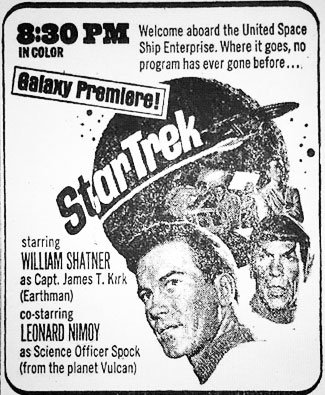 Coate: What is the legacy of Star Trek?
Coate: What is the legacy of Star Trek?
Altman: Fifty years later we’re still talking about Star Trek. I suspect and hope that as long as Star Trek remains optimistic and never cynical, we’ll still be talking about it another 50 years... or, at least, someone will, if not us. It’s a remarkable cultural legacy of which everyone involved has every reason to be proud of. I could not be more excited about the upcoming series from Bryan Fuller knowing that he combines both an enthusiasm for the material as a fan with an unerring aesthetic vision and a brilliant team of writers. Star Trek has always been best on TV. The movie series is fun and engaging when it works, but TV is the beating, bleeding heart of the franchise.
Bond: It’s still being written. I’m very excited about the new TV series coming up, and I will be fascinated to see if it measures up to “peak television” — the standards for television drama are now incredibly high and the new Star Trek series must measure up to them or it’s going to fail. And to measure up to shows like Mad Men and Game of Thrones while still serving the ideals and even the conventions of Star Trek that fans expect is an incredible challenge. But [as I mentioned earlier] it’s stunning and gratifying to me that Star Trek is still viable and a huge part of our culture 50 years after it was first broadcast and almost 50 years after it essentially failed and was cancelled. It’s certainly one of the most amazing success stories in entertainment.
Burnett: The legacy is Star Trek remains the excellence of the human spirit. To think, analyze, and surmount any problem. To excel, to bring the best of the best humanity has to offer to discover the mysteries of the universe. To be the best we can be, to use diversity as a tool, acceptance as a strength and to use intellect as the fulcrum of transcendence. The legacy of Star Trek is the advancement of every being on Planet Earth.
Cushman: The greatest legacy of Star Trek is that we are still watching it, still reading about it, and still talking about it 50 years later. Beyond that, see my answers for [your first question]. If that isn’t one hell of a legacy, what is?
Dochterman: I think the legacy of Star Trek might just be double edged. While it represented a culmination, at least in pop culture, of the Kennedy era dream of space, I think that its vision of the future did inspire a couple generations of scientists and artists to push through new frontiers and advance the human race. Conversely, I do think that there is a little bit of the effect of disappointment in reality. The unfortunate outcome is that Star Trek’s vision was so exciting and distant, that it may have made us a little impatient with the realities of NASA, and that the space program was so far away from the fantastic future that Trek portrayed, it made it difficult to believe that we as a people would ever make it that far…. Recently, I was noting some reactions to the latest SpaceX launch attempt that resulted in a spectacular explosive failure… and saw that so many people were negative and putting this visionary company down for “blowing up another rocket.” I found that appalling and sad that people don’t remember how hard this is, how difficult it is to push technology and nerves past the outside of the envelope… and that they are missing the main tenet of Star Trek: “Risk… Risk is our business. That’s what this starship is all about. That’s why we’re aboard her.” Indeed.
Fontana: We were able to tell stories other shows couldn’t do at the time — stories that addressed racism, feminism, the war in Vietnam, new national and international relationships in a growing, changing world — all under the science fiction mission statement of seeking out new worlds, new civilizations and boldly going where no man has gone before. The stories still hold up, still entertain and touch audiences’ hearts and minds, and are remembered. Not too bad a legacy, I’d say.
Gerani: With the possible exception of Star Wars, it is the most popular and impressive science fiction drama with continuing characters ever created. It taught us that a better world was possible, that the future was an endlessly exhilarating adventure.
Gerrold: It’s curious that we talk about “legacy” — because that’s about the past. Star Trek points toward the future. It has the hopeful optimism of classic science fiction. It says we can do better, we can be better, and we can accomplish amazing things — if we want to. If we put our small petty differences aside. Star Trek is about the essential human aspiration of finding out what’s out there and what’s our place in the universe, because that will give us a real answer to the question, “Who are we?”
Gross: Besides everything that Star Trek stands for — its inherent hope for our future — and characters who have become so iconic, for me one of the great legacies is that for the first time in pop culture history, a television show’s fan base refused to accept the fate one of the networks handed to something they loved. NBC said that Star Trek was over, and the fans said no. That “no” ultimately led to the show’s record-breaking numbers in syndication, the conventions, Star Trek: The Motion Picture and everything that has followed. That’s one hell of a legacy.
Kraft: On television, Star Trek took science fiction from pulp fiction and gave it a heretofore unknown respectability. Its cultural and educational impact have been enormous. Star Trek has become part of the curriculum in higher education, secondary and primary schools in a wide spectrum of academic disciplines, including science, history, ethics, philosophy, theology, law, mathematics, and language. It steers young people to pursue careers in the sciences. It took us on voyages to discoveries in the final frontier of space and into discoveries in the human heart. Most of all, however, it left a legacy of hope and optimism that humankind has a future. If we cultivate the potential of Infinite Diversity in Infinite Combinations so that we embrace a universe brimming with the riches of life in all of its forms, then humankind can evolve into something finer and nobler. I think that is what Gene Roddenberry meant when he said that the human adventure is just beginning.
Pilato: The legacy of Star Trek is impact the show has left behind in the hearts, minds and souls of millions of fans. Besides the fact that the show inspired original designs for things like flip-up cell phones, laptops, and inspired holographic designs that are off and running today, the show gave us hope for the future… that people of all races…different cultures and different religious and spiritual beliefs… that we can all one day work together and live in peace… which is what the show’s canonical term IDIC stood for: Infinite Diversity in Infinite Combinations.
Snodgrass: It presented a hopeful view of the future and was also a window into the attitudes of the 1960s reflecting as it did the Kenndyesque belief in “the new frontier.” Making change through intervention. The number of times Kirk violated the Prime Directive was really rather funny.
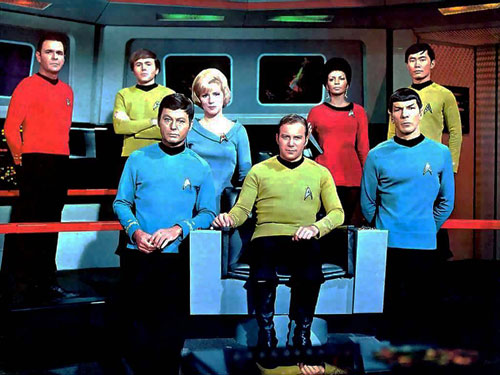
Coate: Thank you, everyone, for participating and for sharing your thoughts about Star Trek on the occasion of its 50th anniversary. Live long and prosper.
In closing, I would like to dedicate this article to the numerous cast and crew members who helped make Star Trek so memorable. On a personal level, I’d like to dedicate this article to James Rhoads, who passed away while this article was being prepared. James was a childhood friend with whom I attended my first Star Trek convention. And to Mr. Don Braden, one of my high school teachers, who had the audacity to screen Star Trek episodes in his tough but rewarding Critical Thinking class, which opened my eyes to the possibility that television could be more than mere entertainment.
Selected images copyright/courtesy CBS, Desilu Productions, NBC, Norway Productions, Paramount Pictures, Paramount Home Entertainment.
– Michael Coate
Michael Coate can be reached via e-mail through this link.
